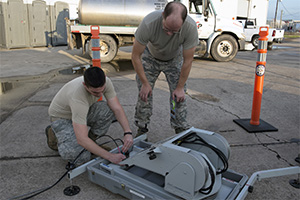Texas Communications Team is ready to save lives
Story by: Sgt. Elizabeth Pena
Posted on: July 22, 2016
 Left, Senior Airman Jeremy Vance, right, Tech Sgt. Christopher Dorriott, set up a mobile satellite dish as part of the Texas Interoperability Communications Package, during a Hurricane evacuation exercise in the Lower Rio Grande Valley, June 7 -10, 2016. The TICP provides communication capabilities for the command and control center during emergency disasters. (Photo by U.S. Army National Guard Sgt. Elizabeth Pena/Released)
Left, Senior Airman Jeremy Vance, right, Tech Sgt. Christopher Dorriott, set up a mobile satellite dish as part of the Texas Interoperability Communications Package, during a Hurricane evacuation exercise in the Lower Rio Grande Valley, June 7 -10, 2016. The TICP provides communication capabilities for the command and control center during emergency disasters. (Photo by U.S. Army National Guard Sgt. Elizabeth Pena/Released)
HARLINGEN, Texas -- Having the immediate communication assets during emergency situations gives military and first responders the ability coordinate and save the lives of local citizens. Texas Air National Guardsmen put their quick response skills action using the Texas Interoperability Communications Package, during a Hurricane evacuation exercise in the Lower Rio Grande Valley, June 7 -10, 2016.
“We have 14 TICPs and they could be sent to any type of scenario,” said Brian Attaway, director of J6. “They can support our own command and control purposes, or the state requests them to go support another agency. They’ve done fires and hurricanes; they’ve supported police departments and supported Texas Task Force 1. In this case, our TICP was assigned to the Air Guard that they needed to use in Harlingen.”
Texas Guardsmen and active duty Air Force worked with state and local first responders at the Valley International Airfield to transport mock patients through military and civilian aircraft. Within one hour of arrival, the four-man team set up the TICP to give key leaders the ability to coordinate those operations.
“If you’re out in the middle of nowhere and a tornado touches down and you’ve got no cell phone, no power, no light, no anything we can roll up with our generator power and establish mobile satellite communications, and that’s pretty significant,” said Texas Air National Guard Staff Sgt. Lonnie Dunkin, a cyber transport specialist with the 149th Mission Support Group, out of Lackland Air Base, San Antonio.
For the exercise, the TICP provided satellite, Internet and phone services. Airmen also set up a mobile satellite dish to the portable network control center and extended services via cable router, said Dunkin. These services supported the tactical air control Party.
The tactical air control party is made up of Air Force personnel, who work alongside the Army on ground to provide airspace deconfliction and terminal control of close air support.
The TICP trailer comes equipped with many different assets.
“It has more than just phones and Internet,” said Attaway. “It has computers on board, WI-FI, a printer a fax, and it’s got an antenna tower, and radios, which are connected, to our network. All the radios are for our purposes and for interoperability with other agencies. We can also stream video.”
Additionally, the TICP can provide communication means for local citizens stuck in disaster situations.
“We can set up five or six terminals and that would allow for any user to come up and check their bank accounts or email, and send out a message to friends and family letting them know they’re okay,” said Dunkin.
The TICP was first implemented during the 2008 hurricanes Ike and Gustav. Since then, the package has deployed to hurricanes, fires and various other support missions across the state,” said Attaway.
“During Hurricane Ike we got tasked by the state to go help the Pasadena Police Department, as it was completely down,” said Attaway. “They had no phones they had no radios, the hurricane had completely wiped them out. So we sent a TICP down and to PPD and the people had to call the TICP to reach the police. They were announcing on the radio ‘you cant call 911 you have to call this phone number.”
The command and control center, based out of Camp Mabry in Austin, Texas, currently maintains the TICPs for the state.
“We hand receipt them out to Army Guard, Air Guard and even State Guard who have them throughout the year and then when we have a big exercise or state emergency we send the nearest one that’s available,” said Attaway.
Disaster response exercises like these give Texas Guardsmen and local and state authorities the experience to handle situations should a real-world emergency occur.
“In my opinion, communications is the bread and butter of successful operations,” said Air Force Tech Sgt. Christopher Dorriott, noncommissioned officer in charge of the exercise training for the 149th Fighter Wing, based out of Lackland. “If they need to go on search-and-rescue missions, if they need to go medevac somebody out, or work with local law enforcement, there has to be somebody who can branch those organizations together so they can properly coordinate and get people where they need to go.”
This is four of the four Texas Hurricane Preparedness series.